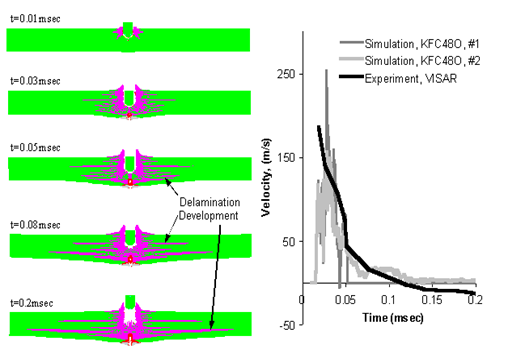An orthotropic material model coupled with a polynomial equation of state has been used to conduct numerical investigations of FSP (Fragment Simulating Projectile) impacts on Kevlar fiber Reinforced Panel (KFRP) systems used for personal protective clothing armor [13]. Results of these investigations are shown below and compared with instrumented ballistic impact experiments carried out at TNO Prins Maurits Laboratory. The experiments included measurement of target back surface velocity during the impact using VISAR techniques.
In this work, the coupled anisotropic material model was used to simulate the case of a 1.1g steel fragment impacting an aramid composite plate at 483m/s. The Lagrange processor of Autodyn-2D was used to represent both fragment and composite target.
The aramid composite is made up of 19 layers of woven Kevlar 29 bonded in Epoxy. Basic quasi-static elastic properties for the composite were known although no dynamic material properties that would allow the derivation of nonlinear shock terms were available. In the initial simulation work reported in [13], the material properties for Kevlar-129/Epoxy derived in [1] were used along with the polynomial equation of state. The 4340 steel fragment was represented using a Johnson-Cook strength model and data.
Figure 7.10: Fragment Impact on KFRP at 483m/s, Simulation and Experimental Results
 | |
a) Simulated Damage Development | b) Back surface Velocity |


